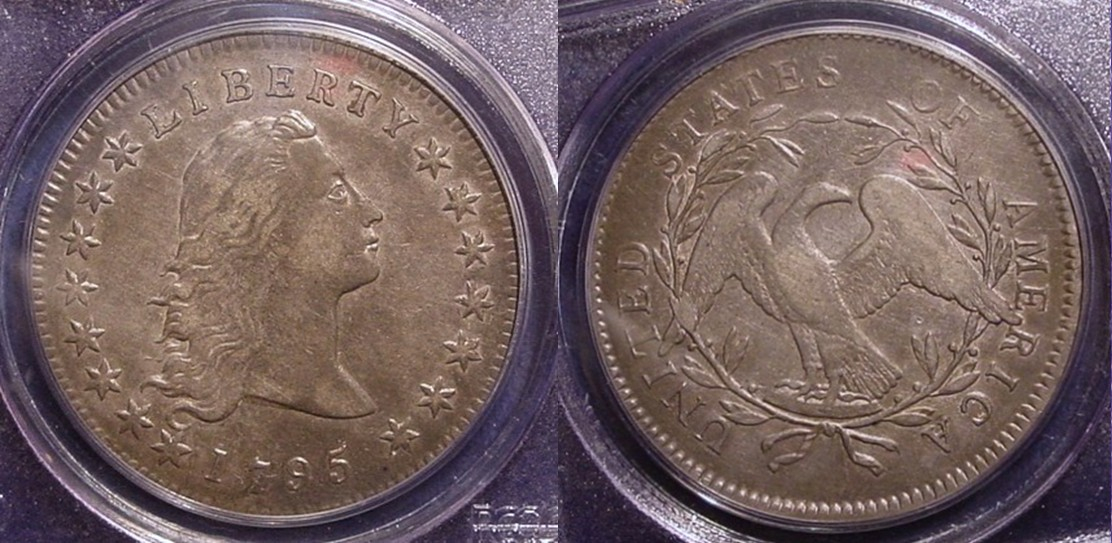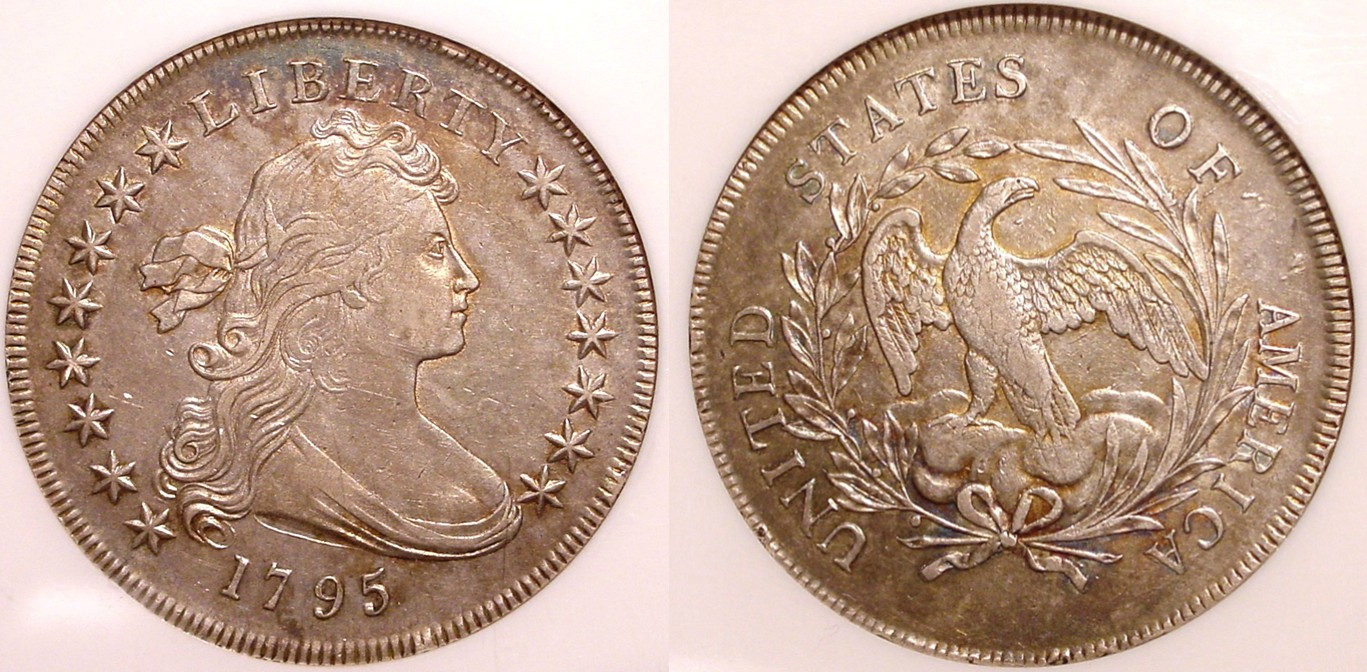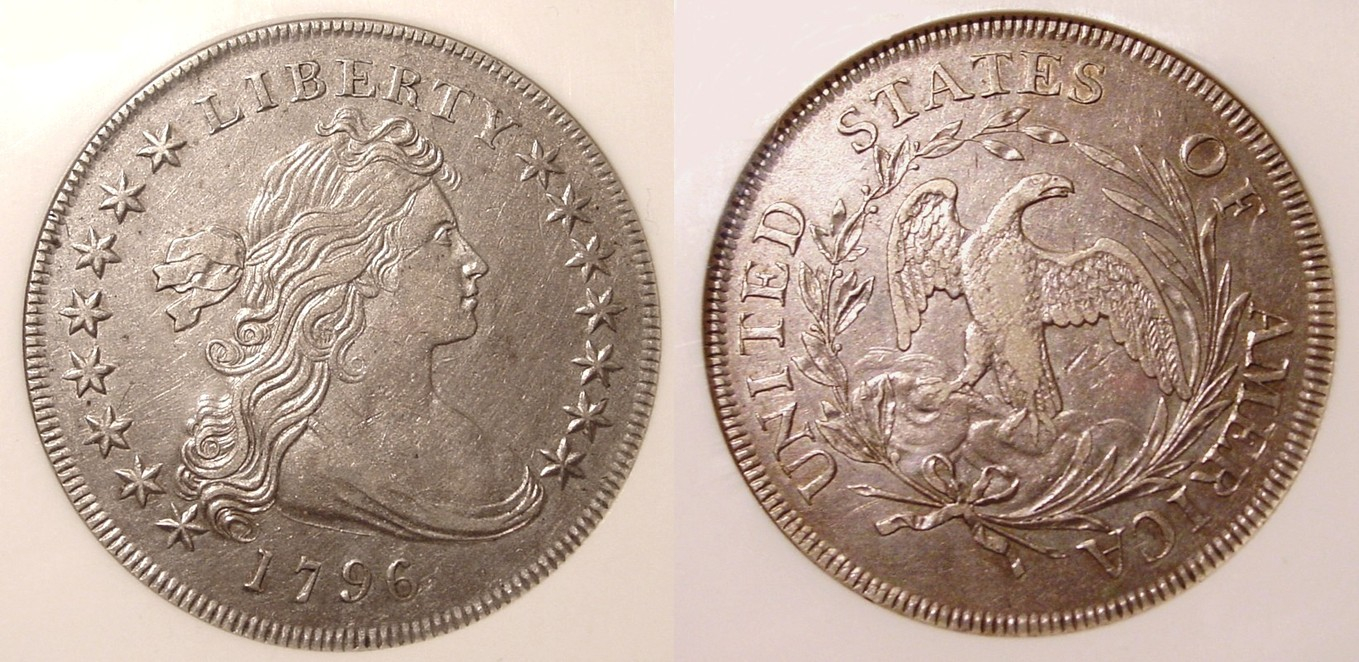Howdy, Stranger!
It looks like you're new here. If you want to get involved, click one of these buttons!
Quick Links
A Guide to Collecting the Early U.S. Silver Dollars by Date and Major Design Type, Part 2

The 1795 Dollars
The 1795 dollars were made in two design types, the Flowing Hair and Draped Bust designs. The Flowing Hair coins were quite similar, but not identical to the 1794 dollars. In these years considerable hand work went into the making of coinage dies. Therefore the placement of the date, lettering and some minor design details, like the number of leaves in the wreath, varied. Major devices, such as the bust of Liberty and the eagle and wreath on the reverse were standardized to a point but were frequent adjusted and replaced in the early years of the mint. The need for a new, larger coin press delayed the production of the silver dollar until May 1795. During the interim period, the mint concentrated upon the half dime and half dollar, making those two issues fairly common compared to other early U.S. silver coins. No copper coins were struck because Congress was pressuring the mint to get silver and gold coins into circulation. Finally, on May 6, the first delivery of silver dollars, 3,810 pieces, was made. Deliveries continued throughout the summer and into the fall.
Mintages and Rarity
According to “The Red Book,” the mintage for the 1795 Flowing Hair dollar was 160,295 pieces. “Coin Facts,” a numismatic information site that the PCGS grading service maintains, estimates that there are 10,250 surviving examples. That calculates to a survival percentage of 6.4%, which seems too high.
David Bowers addressed the annual mintage issue in his two volume Silver Dollar encyclopedia. Bowers agrees that the total mintage for all years of 1,446,106 is accurate. The questions concern the reported annual mintages. The mintages reported in “The Red Book” are based upon the total deliveries of coins reported in a calendar year. Although the delivery numbers are accurate, the issue is, what were the dates on the coins when they were delivered? During the early days of the mint, budgets were low and the cost of making dies was high. Therefore, a change in the calendar year did not prompt the summary discarding of perfectly good coinage dies despite the fact that the law called for the date on a coin to match its year of issue.
In view of this, Bowers theorizes that the dies for the Flowing Hair dollars may have been used as late as 1798. None of this can be proven, and the mintage adjustment estimates are no more than educated guesses. As we shall see later, there are ongoing issues with the “official” mintage figures that appear in “The Red Book.” Bowers estimated that the actual mintage for the Flowing Hair dollars was 280,000 which would make the survival percentage 3.7%. That is more in line with the overall survival rates for the entire early dollar series.
Under the same assumptions, Bowers increased the mintage for the 1795 Braided Hair Dollar from 42,738 to 110,000. Given an estimate of 3,900 survivors, the survival rate falls from 9.1% to 3.5%.
Adjustment Marks and Plugs
Planchet preparation was an imprecise science in the 1790s and early 1800s. Therefore each planchet had be weighed, before it was struck, to determine if it met the legal standard. Planchets that weighed too much were lightened by running a file over the surface and catching the resulting silver fragments in a leather apron. Some of these marks were obliterated when the coins were struck, but on a fair number of early gold and silver coins, these parallel lines show on the surface of the piece. These lines are called adjustment marks. Since they are a part of the minting process, they do not reduce the technical grade of piece, but they can reduce the market value if they are significant and make the coin unattractive.
Underweight planchets also had to be flagged. In all cases, except in 1794 and 1795, these planchets were melted and the planchet production process had to be repeated. In 1794 and 1795 a comparatively small number of silver dollars had a silver plug driven into the center of the planchet to increase the weight to the legal standard. An estimated 250, 1795 Flowing Hair dollars have a silver plug, which appears in the center of the piece. These coins command premium prices.

1796 Dollars
The year 1796 was a unique one for the first Philadelphia Mint. It is only year in during which the facility struck all ten denominations that were authorized by the Coinage Act of 1792. Some of those coins, such as the half cent, half dollar and quarter eagle are rare and expensive. Still that has not discouraged several collectors from trying to form year sets or even “Proof sets” of exceptional quality 1796 coins.
The 1796 dollars are moderately scarce with estimated surviving population of 3,200 pieces. The reported mintage is 79,920. The Bowers estimate is close to that at 75,000. There are “Red Book” varieties with small and large and letters and different star configurations in three combinations.
The half dollar mintage fell from 299,680 in 1795 to a combined total of 3,918 pieces for the years 1796 and 1797. This was the normal mintage pattern for half dollars during the early years of the first U.S. Mint. When silver dollars were not available, the depositors asked for half dollars. When silver dollar production went back on line, the depositors order far fewer half dollars. When the coinage of the silver dollar ended in 1804, half dollar production greatly increased.


Comments
Thank you Bill for the articles and research!